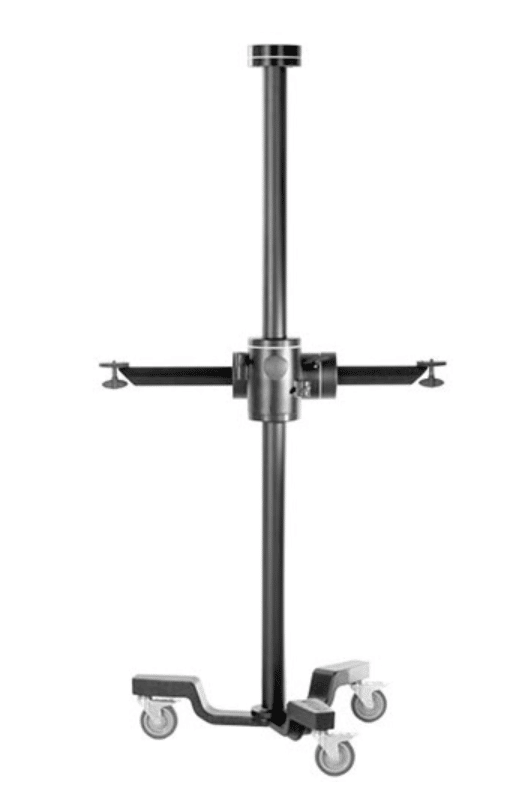I remember several photographic purchases that changed my photography dramatically for the better.
- Nikon S2, in 1957
- Nikon FTn, in 1966
- Hasselblad 501c
- Linhof Master Technika
- Nikon D3
- Arca Swiss C1 cube
- Sony a9
- 8×10 Polaroid processor
But there’s one that stands head and shoulders above the rest for impact on my photography, the Foba Portrait Pro camera stand. It’s one of the cheaper Foba stands, but it’s not inexpensive. I imagine that I’d be happy with any good quality camera stand. But I had no idea when I bought it what a difference it would make.
It was a happenstance purchase. I had a credit at my photo dealer, and the money was burring a hole in my pocket. I’d been eyeing camera stands in stores for 50 years, but I’d never owned one. This one was light enough that two people could assemble and set it up. So I ordered it, not having much in the way of expectations.
I was then, and still am, doing most of my photography in the studio, which is the natural place to use a camera stand. You’d have to be a masochist to try to use one in the field. Camera stands are big. Camera stands are heavy; in fact their great weight allows them to do what they do better than if they were made out of carbon fiber.
What’s their big advantage? It’s actually threefold: they allow precise and rapid positioning of the camera, and they do it in a way that doesn’t sacrifice stability. And they do it in a way that allows positions and angles that are either impossible, or awkward using tripods.
- Want to shoot straight down? No problem.
- Want the camera positioned really close to, or even over, a table? Piece of cake.
- Want to move the camera one centimeter to the right? Easy.
- Want a more stable platform than you could possibly get with a tripod? At your service.
- Want to raise the camera by 1 cm without using a shake-inducing center column. Falling off a log.
- Want the camera up near the ceiling, or down near the floor? Can do.
- Want a computer/monitor/accessory table that is always near the camera? Snap it right in.
- Want a piece of gear that feels precise under your hands? Got you covered.
Your mileage may vary, but if you’ve been tempted, give it a whirl.

Erik says
very unique and interesting piece of gear. never even know this existed. if it wasn’t so damn expensive, i’d give it a try.
Ellis Vener says
If I had a studio – 99% of my work is done at client’s locations or in the field – the very first first photographic tool I’d buy is a camera stand, and it would be a Foba. The photographer I apprenticed with in the 1980s had one made by Arkay and while it was okay it dod not have the sliding arm of the Foba, Cambo, and other brands of camera stands I have used in rental studios since then. Far and away the best, and the best bang for the buck have been the ones made by Foba.
There was a photographer I knew in the 1980s-’90s who shot cars on location with an 8×10 Sinar P2. His clients ranged from Ferrari to Ford plus various magazines. The locations ranged from cities to deserts. He and his crew always brought the bigger brother of this camera stand – the Foba Asaba model – with them. I can not imagine how much hassle that must have been but he swore by it. I imagine his assistants swore at it.
Darius says
I am curious about the A9 making the list, do you have this in another post how the A9 changed your photography?
Many thanks
JimK says
The a9 allowed me to take pictures where silence was essential without having to worry much about the illumination banding that occurred with slower electronic shutters. And the frame rate let me do sequences I couldn’t otherwise do.
Mark Rehfield says
My major enabling technologies have some similarities to yours:
Pentax H1a in 1967
Nikon FTn in 1970 (which I still have and occasionally put film through!)
Beseler 45MCRX enlarger purchased in 1971, used until I moved to Central Coast in 2013
Cambo 4×5 in 1972 (the Linhof Technical I bought in 1971 was not as effortless to use movements on)
Hasselblad 500cm in 1980 FINALLY gave me the portability, image quality, and flexibility to do medium format travel, nature, people photography.
Photoshop in mid ‘90s
Nikon D100 in 2003
Nikon D3 for high sensitivity allowing nighttime and astrophotography
Sony A9 for silent photography without artifacts and sensor stabilization not available on DSLRs
iPhone for near 100% availability of imaging capability
Next???